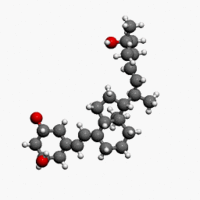Paricalcitol
 | |
 | |
| Clinical data | |
|---|---|
| Trade names | Zemplar |
| AHFS/Drugs.com | Monograph |
| MedlinePlus | a682335 |
| Pregnancy category | |
| Routes of administration | Oral, Intravenous |
| ATC code | H05BX02 (WHO) |
| Legal status | |
| Legal status | |
| Pharmacokinetic data | |
| Bioavailability | 72%[1] |
| Protein binding | 99.8%[1] |
| Metabolism | Hepatic[1] |
| Biological half-life | 14-20 hours[1] |
| Excretion | Faeces (74%), urine (16%)[1] |
| Identifiers | |
| |
| Synonyms | (1R,3S)-5-[2-[(1R,3aR,7aS)-1-[(2R,5S)-6-hydroxy-5,6-dimethyl-3E-hepten-2-yl]-7a-methyl-2,3,3a,5,6,7-hexahydro-1H-inden-4-ylidene]ethylidene]-cyclohexane-1,3-diol |
| CAS Number |
131918-61-1 |
| PubChem (CID) | 5281104 |
| IUPHAR/BPS | 2791 |
| DrugBank |
DB00910 |
| ChemSpider |
4444552 |
| UNII |
6702D36OG5 |
| KEGG |
D00930 |
| ChEBI |
CHEBI:7931 |
| ChEMBL |
CHEMBL1200622 |
| ECHA InfoCard | 100.184.862 |
| Chemical and physical data | |
| Formula | C27H44O3 |
| Molar mass | 416.636 g/mol |
| |
| | |
Paricalcitol (chemically it is 19-nor-1,25-(OH)2-vitamin D2. Marketed by Abbott Laboratories under the trade name Zemplar) is a drug used for the prevention and treatment of secondary hyperparathyroidism (excessive secretion of parathyroid hormone) associated with chronic renal failure. It is an analog of 1,25-dihydroxyergocalciferol, the active form of vitamin D2 (ergocalciferol).
Medical uses
Its primary use in medicine is in the treatment of secondary hyperparathyroidism associated with chronic kidney disease.[2] In three placebo-controlled studies, chronic renal failure patients treated with paricalcitol achieved a mean parathyroid hormone (PTH) reduction of 30% in six weeks. Additionally there was no difference in incidence of hypercalcemia or hyperphosphatemia when compared to placebo.[3] A double-blind randomised study with 263 dialysis patients showed a significant advantage over calcitriol (also known as activated vitamin D3; a similar molecule to 1,25-dihydroxyergocalciferol, adding a methyl group on C24 and lacking a double-bond in the C22 position). After 18 weeks, all patients in the paricalcitol group had reached the target parathormone level of 100 to 300 pg/ml, versus none in the calcitriol group.[4] Combination therapy with paricalcitol and trandolapril has been found to reduce fibrosis in obstructive uropathy.[5] Forty-eight week therapy with paricalcitol did not alter left ventricular mass index or improve certain measures of diastolic dysfunction in 227 patients with chronic kidney disease.[6]
Adverse effects
Adverse effects by frequency:[1][2][7][8]
Very common (>10% frequency):
- Nausea
Common (1-10% frequency):
- Diarrhoea†
- Oedema
- Allergic reaction
- Arthritis
- Dizziness†
- Stomach discomfort‡
- Gastroesophageal reflux disease†
- Acne†
- Hypercalcaemia†
- Hypocalcaemia†
- Hyperphosphataemia
- Decreased appetite†
- Headache
- Breast tenderness†
- Taste changes
- Hypoparathyroidism
- Vertigo
- Rash‡
Uncommon (0.1-1% frequency):
- Abnormal hepatic enzymes‡
- Constipation‡
- Dry mouth‡
- Itchiness‡
- Hives
- Hypersensitivity‡
- Muscle spasms‡
- Bleeding time prolonged
- Aspartate aminotransferase increased
- Laboratory test abnormal
- Weight loss
- Elevated blood creatinine
- Cardiac arrest
- Arrhythmia
- Atrial flutter
- Anaemia
- Leucopenia
- Lymphadenopathy
- Coma
- Stroke
- Transient ischemic attack
- Fainting
- Myoclonus
- Hypoaesthesia
- Paraesthesia
- Glaucoma
- Conjunctivitis
- Ear disorder
- Pulmonary oedema
- Asthma
- Shortness of breath
- Nose bleed
- Cough
- Rectal haemhorrhage
- Colitis
- Gastritis
- Indigestion
- Difficulty swallowing
- Gastrointestinal disorder
- Gastrointestinal haemorrhage
- Bullous dermatitis
- Hair loss
- Hirsutism
- Hyperhidrosis
- Joint pain
- Joint stiffness
- Back pain
- Muscle twitching
- Muscle aches
- Hyperparathyroidism
- Hyperkalaemia
- Hypocalcemia
- Breast cancer
- Sepsis
- Pneumonia
- Infection
- Pharyngitis
- Vaginal infection
- Influenza
- High blood pressure
- Hypotension
- Gait disturbance
- Injection site pain
- Fever
- Chest pain
- Condition aggravated
- Muscle weakness
- Malaise
- Thirst
- Breast pain
- Impotence
- Confusional state
- Delirium
- Depersonalization
- Agitation
- Insomnia
- Nervousness
‡ These are adverse effects only seen in patients with grade 3 or 4 chronic kidney disease. † These are adverse effects only seen in patients with grade 5 chronic kidney disease.
Contraindications
Contraindications include:[8]
- Vitamin D intoxication
- Hypercalcaemia
- Hypersensitivity to paricalcitol or any of its excipients
whereas cautions include:[1]
- Impaired liver function
- It is also advised that physicians regularly monitor their patients' calcium and phosphorus levels.
Interactions
Drugs that may interact with paricalcitol include:[1][8]
- Ketoconazole, as it may interfere with paricalcitol's metabolism in the liver.
- Digitoxin, hypercalcaemia due to any cause can exacerbate the toxicity of digitoxin.
- Thiazide diuretics or calcium supplements as hypercalcaemia may be induced by this combination
- Magnesium-containing products such as antacids may increase the risk of hypermagnesemia.
- Aluminium-containing products such as antacids may increase the risk of aluminium toxicity.
- Drugs that interfere with the absorption of fat-soluble vitamins, such as cholestyramine may interfere with the absorption of paricalcitol.
Overdose
Electrolyte abnormalities (e.g. hypercalcaemia and hyperphosphataemia) are common overdose symptoms.[8] Treatment is mostly supportive, with particular attention being paid to correcting electrolyte anomalies and reducing intake of calcium in both the form of supplementation and diet.[8] As it is so heavily bound to plasma proteins haemodialysis is unlikely to be helpful in cases of overdose.[8]
Early symptoms of overdose can include:[8]
- Weakness
- Headache
- Somnolence
- Nausea
- Vomiting
- Dry mouth
- Constipation
- Muscle pain
- Bone pain
- Metallic taste in the mouth.
It is worth noting, however, that may of these symptoms are also indicative of kidney failure and hence may be masked by the patient's condition.[8]
Late symptoms of overdose include:
- Loss of appetite
- Weight loss
- Conjunctivitis (calcific)
- Pancreatitis
- Photophobia
- Rhinorrhoea
- Pruritus
- Hyperthermia
- Decreased libido
- Elevated BUN
- Hypercholesterolaemia
- Elevated AST and ALT
- Ectopic calcification
- Hypertension
- Cardiac arrhythmias
- Somnolence
- Death
- Psychosis (rare)
Mechanism of action

Like 1,25-dihydroxyergocalciferol, paricalcitol acts as an agonist for the vitamin D receptor and thus lowers the bloodparathyroid hormone level.[1]
Pharmacokinetics
Within two hours after administering paricalcitol intravenous doses ranging from 0.04 to 0.24 µg/kg, concentrations of paricalcitol decreased rapidly; thereafter, concentrations of paricalcitol declined log-linearly. No accumulation of paricalcitol was observed with multiple dosing.[9]
References
- 1 2 3 4 5 6 7 8 9 "Zemplar (paricalcitol) dosing, indications, interactions, adverse effects, and more". Medscape Reference. WebMD. Retrieved 26 January 2014.
- 1 2 Rossi, S, ed. (2013). Australian Medicines Handbook (2013 ed.). Adelaide: The Australian Medicines Handbook Unit Trust. ISBN 978-0-9805790-9-3.
- ↑ "Zemplar: Drug Information"
- ↑ Schubert-Zsilavecz, M, Wurglics, M, Neue Arzneimittel 2005/2006 (in German).
- ↑ Tan, X; He, W; Liu, Y (2009). "Combination therapy with paricalcitol and trandolapril reduces renal fibrosis in obstructive nephropathy". Kidney International. 76 (12): 1248–57. doi:10.1038/ki.2009.346. PMID 19759524.
- ↑ Thadhani, R; Appelbaum, E; Pritchett, Y; Chang, Y; Wenger, J; Tamez, H; Bhan, I; Agarwal, R; et al. (2012). "Vitamin D Therapy and Cardiac Structure and Function in Patients With Chronic Kidney Disease - The PRIMO Randomized Controlled Trial". JAMA. 307 (7): 674–684. doi:10.1001/jama.2012.120. PMID 22337679.
- ↑ "PARICALCITOL capsule, liquid filled [Teva Pharmaceuticals USA Inc]" (PDF). DailyMed. Teva Pharmaceuticals USA Inc. September 2013. Retrieved 26 January 2014.
- 1 2 3 4 5 6 7 8 "Zemplar Soft Capsules 1 mcg - Summary of Product Characteristics". electronic Medicines Compendium. AbbVie Limited. 15 April 2013. Retrieved 26 January 2014.
- ↑ Rxlist: Zemplar